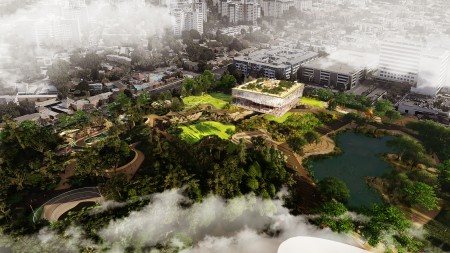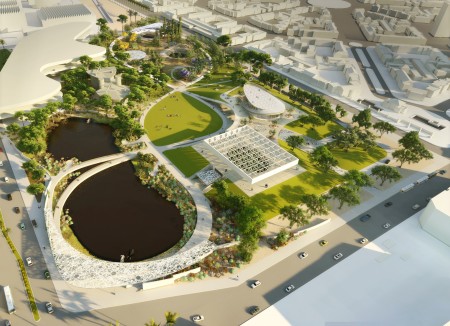Press release (Revised 9/16/19)
NATURAL HISTORY MUSEUMS OF LOS ANGELES COUNTY uNVEIL THREE PRELIMINARY CONCEPTS TO REIMAGINE LA BREA TAR PITS
Initial Approaches Toward a Master Plan Will Be on View at La Brea Tar Pits and Museum and on TarPits.org - August 27, 2019 – September 15, 2019
Los Angeles, August 26, 2019 – Dr. Lori Bettison-Varga, President and Director of the Natural History Museums of Los Angeles County (NHMLAC), today, at a public presentation, unveiled three preliminary conceptual approaches to a master plan for the world-famous La Brea Tar Pits. Made available for viewing at the Tar Pits and Museum and on TarPits.org, the varied concepts are early contributions to improve the entire 13-acre site, which has not been renovated or considered comprehensively since it opened more than forty years ago. Prepared by multidisciplinary teams led by three renowned architectural firms—Dorte Mandrup (Copenhagen), Diller Scofidio + Renfro (New York) and WEISS/MANFREDI (New York)—the concepts envision a more integrated experience of the museum and the landscape in Hancock Park while increasing community access, preserving the site’s iconic features and developing a more sustainable infrastructure.
“After embarking on the process to reimagine La Brea Tar Pits earlier this year, we selected three firms with established expertise in integrating public green space with museum collections to help us see the site with fresh eyes,” said NHMLAC President and Director, Dr. Lori Bettison-Varga. “They did not disappoint. These three concepts offer us distinct approaches to consider—all of them are deeply thoughtful, and all have responded fully to our stated goals: We want to preserve and enhance community use of Hancock Park while making the collection more visible to the public, showing science in action, and adding to our visitor amenities. All three submissions offer fascinating ideas for creating a more robust and engaging visitor experience while enhancing the Tar Pits as a destination and cultural hub that inspires wonder in our natural and cultural worlds. We look forward to hearing the public’s response to this exciting step toward preparing our campus for the next 50 years of research and public service.”
The Natural History Museums of Los Angeles County are a public / private partnership with the County of Los Angeles, which owns the 23 acres of Hancock Park, including the 13-acre parcel managed by NHMLAC. Los Angeles County Supervisor Sheila Kuehl said, “La Brea Tar Pits and the Page Museum are enormously popular and valuable cultural assets for the County, attracting neighbors, school children from across the metropolitan area, and visitors from around the world. The Tar Pits are known everywhere as a visual symbol of the cultural and long natural history of Los Angeles. The Board of Supervisors is proud to support this forward-thinking effort by the Natural History Museums to create a vibrant and engaging future for this exciting and important public resource.”
Three Distinct Visions
In March 2019, NHMLAC asked a select, international group of architecture firms to assemble teams of landscape architects, scientists, engineers, designers and artists to begin to reimagine La Brea Tar Pits. The three finalist teams participated in a special “ideas incubator” held in June 2019 during which more than seventy leading figures from the fields of science, the arts, design, entertainment, education, technology, communications, philanthropy, and government gathered for a day of open-ended discussion. These discussions helped to inform the varied creative approaches unveiled today by NHMLAC at a community event where principals from the three firms gave public presentations about their approaches.
Dorte Mandrup
“For the residents of Los Angeles, Hancock Park and the Page Museum are nostalgic places that bring back memories,” said Dorte Mandrup-Poulsen, Founder and Creative Director of the studio Dorte Mandrup. "We will cherish and build on this, as we open up and extend the park and museum to become one big living laboratory. Our proposal interweaves the park and museum, so the moment you step inside the park you become immersed into the story of the Tar Pits. A visit here should be a journey of curiosity, where senses and imagination are instantly awakened. Our hope is that this will bring visitors much closer to the world of natural science, and in turn heighten their understanding of the past, present and future of our planet.”
Diller Scofidio + Renfro
"As an urbanized culture, we are rarely conscious of the geological forces that shape the ground we walk (and drive) on. A new masterplan for the La Brea Tar Pits and Page Museum offers a unique opportunity to not only heighten awareness of the natural history held underfoot, but also to engender a sense of responsibility towards the role humans play in shaping the environment they inherit,” said Diller Scofidio + Renfro. “A revitalized Hancock Park is conceived to be the connective tissue between existing and new institutions, public spaces, and urban infrastructure. We have taken a ‘light touch’ approach for the next evolution of the Page Museum, infilling underutilized spaces and reconfiguring what is already there to create a more dynamic and efficient hybrid structure that is both building and landscape."
WEISS/MANFREDI
“WEISS/MANFREDI’s proposal, ‘La Brea Loops and Lenses,’ redefines Hancock Park and the Page Museum as one continuous experience,” said Founders and Principals Marion Weiss and Michael Manfredi. “The intertwining loops link all the existing site components, enhancing spaces for community and scientific research. The lenses, as framed views throughout the park and museum, reveal the La Brea collection to visitors, bringing the museum to the park, and the park into the public imagination. We are excited to reimagine La Brea and are committed to amplifying this enduring Los Angeles landmark to serve a vibrant community.”
Up Next
Displays prepared by the three teams will be on public view in the museum at La Brea Tar Pits through September 15, with materials including models, renderings and drawings. Digital versions of the materials can be found on TarPits.org. The public is encouraged to provide feedback onsite or online.
To assist with their selection, NHMLAC assembled a jury of leading figures from the fields of architecture, landscape architecture, design, science, natural history and the arts including Milton Curry, Dean of USC School of Architecture; Christopher Hawthorne, Chief Design Officer, City of Los Angeles; Kirk Johnson, Director of the National Museum of Natural History, Smithsonian Institution; Kristin Sakoda, Executive Director, Los Angeles County Department of Arts and Culture; and Barbara Wilks, Founding Principal and Architect, W Architecture and Landscape Architecture, LLC.
Based on its own review of these concepts, input from the jury, and the public’s feedback, NHMLAC expects to choose one firm by the end of December 2019. The firm will then lead a multi-disciplinary creative team through a public engagement, master planning, design and construction process over the next several years.
The La Brea Tar Pits Campus
The only active paleontological research facility in the world that is located in a major urban area, La Brea Tar Pits is situated within the eastern portion of Hancock Park in Los Angeles’s Miracle Mile district. Since research began in 1913, the Tar Pits have yielded millions of samples, including saber-toothed cats, dire wolf and mastodon skeletons, innumerable plants, small rodents, and insects, and new discoveries are made daily in the Tar Pits open-air excavations. These collections constitute an unparalleled resource for understanding environmental change in Los Angeles, and the planet, during the last 50,000 years of Earth’s history.
The George C. Page Museum, designed by Los Angeles architects Frank Thornton and Willis Fagan, opened in 1977. Burrowed into the earth to preserve as much of the landscape as possible, it has sloping, grass-covered exterior walls, which are a beloved feature of Hancock Park, and is surmounted by a 10-foot-high, 4-sided fiberglass frieze of Ice Age landscapes, plants, and mammals, created by the sculptor Manuel Paz. The 57,000-square-foot-museum has more than 2 million specimens in its collection. Because of the building’s shape and underground siting, however, the museum is difficult to modify and expand, to the detriment of its programs in exhibition, education, research, and storage.
In addition to the Tar Pits and the museum, the campus comprises several active digs, an Observation Pit building from the 1950s (refurbished in 2014), a concession building, simulated Pleistocene landscapes, and contemporary gardens.
Over the past few years, NHMLAC has made an ongoing series of improvements and enhancements to the Tar Pits, the museum and its portion of the park. The current installation of the Second Home Serpentine Pavilion by selgascano (on view through November 24, 2019) is a celebration of architectural design and a temporary site for free public events. The next in the series will be an Augmented Reality experience, to be introduced in fall 2019.
About the Natural History Museums of Los Angeles County
The Natural History Museums of Los Angeles County (NHMLAC) include the Natural History Museum in Exposition Park (NHM), La Brea Tar Pits, and the William S. Hart Museum. They operate under the collective vision to inspire wonder, discovery, and responsibility for our natural and cultural worlds. The museums hold one of the world’s most extensive and valuable collections of natural and cultural history—more than 35 million objects. Using these collections for groundbreaking scientific and historic research, the museums also incorporate them into nature and culture exploration in L.A. neighborhoods, and a slate of community science programs—creating a natural history museum experience that explores the past, but increasingly addresses the present and the future. Learn more here.
About La Brea Tar Pits
The asphalt seeps at La Brea Tar Pits are the only consistently active and urban Ice Age excavation site in the world. This makes the site a unique window into active science—where fossils are discovered, prepared, researched, and displayed in one place. Outside, visitors can watch excavators unearth fossils of the wildlife trapped in the seeps. Inside the Museum, scientists and volunteers clean, repair, and identify those very fossils. The best specimens are displayed and available for research: from extraordinary saber-toothed cats, giant sloths, dire wolves, mammoths, and mastodons—to microfossils of small animals and plants. These collections constitute an unparalleled resource for understanding environmental change in Los Angeles, and the planet, during the last 50,000 years of Earth’s history.
Dorte Mandrup
Dorte Mandrup is a Danish architecture studio specialized in ambitious landmark projects for irreplaceable places of great importance to our world heritage. The studio designs architecture from an artistic point of view, with an ability to evoke the identity of fragile places and actively involve the surrounding nature or urban context. Rooted in Scandinavian heritage, the team naturally considers all human scale aspects in their approach to creating sustainable, conceptual and artistic architectural solutions. Dorte Mandrup’s work has received national and international acclaim, such as Berlin Art Prize, Finn Juhl Architecture Award, the Honorary Award of the Danish National Bank Jubilee Fund Berlin Art Prize, and The Eckersberg Medal. In 2019 she was chairwoman of the EU Mies van der Rohe Award, she is Vice Chairman of the Louisiana Museum of Modern Art, member of the Historic Buildings Council, Adjunct Professor at The Royal Danish Academy of Fine Arts, and acts as frequent visiting professor including in 2018 at Cornell University College of Architecture, Art, and Planning. As a frequent voice in public debate, she is well known for her commitment to the development of the architectural profession and its role in society. Their team for reimagining La Brea Tar Pits includes landscape architect Martha Schwartz Partners NYC, visual designers Kontrapunkt, LA based executive architects Gruen Associates and engineering firm Arup Los Angeles.
For more information visit www.dortemandrup.dk
WEISS/MANFREDI Architecture/Landscape/Urbanism
WEISS/MANFREDI Architecture/Landscape/Urbanism is at the forefront of architectural design practices that are redefining the relationships between landscape, architecture, infrastructure, and art. Named one of North America's "Emerging Voices" by New York’s Architectural League, WEISS/MANFREDI won the 2018 Cooper Hewitt Smithsonian Institution’s National Design Award as well as the New York AIA Gold Medal, and the Academy Award in Architecture from the American Academy of Arts and Letters. Most recently, WEISS/MANFREDI was honored with the Mercedes T. Bass Landscape Architects in Residence Fellowship at the American Academy in Rome. The firm's cross-disciplinary projects include the Seattle Art Museum's Olympic Sculpture Park, recognized as one of Time Magazine’s Ten Best Architectural Marvels, the Brooklyn Botanic Garden Visitor Center, Penn’s Center for Nanotechnology, the Women’s Memorial at Arlington Cemetery, the Museum of the Earth, and the recently opened Hunter's Point South Waterfront Park. They are currently working on the US Embassy in New Delhi, India. Their team for reimagining La Brea Tar Pits includes brand and graphics designer Michael Beirut, paleobotanist Dr. Carol Gee, artist Mark Dion and Los Angeles-based Emmy Award-winning designer Karin Fong of Imaginary Forces.
For more information visit weissmanfredi.com.
Diller Scofidio + Renfro (DS+R)
Founded in 1981, Diller Scofidio + Renfro is a multidisciplinary design studio with a focus on cultural and civic projects. Based in New York, the studio is comprised of over 100 architects, designers, artists and researchers, led by four partners—Elizabeth Diller, Ricardo Scofidio, Charles Renfro and Benjamin Gilmartin. Their work has been distinguished with the first MacArthur Foundation fellowship awarded in the field of architecture, Time Magazine's "100 Most Influential" list, the Smithsonian Institution's 2005 National Design Award, the Medal of Honor and the President's Award from AIA New York, and Wall Street Journal Magazine's 2017 Architecture Innovator of the Year Award. Recent projects include The Shed in New York; The Broad, a contemporary art museum in Los Angeles; and the 35-acre Zaryadye Park adjacent to the Kremlin in Moscow. This year, the studio will open an expansion of The Museum of Modern Art (MoMA) in New York. Their team for reimagining La Brea Tar Pits includes California-based landscape architects Rana Creek and landscape architect and urban theorist Walter Hood.
For more information visit dsrny.com.
MEDIA CONTACT
Sally Marquez
smarquez@nhm.org
213.763.3580



